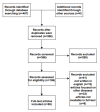The Role of Tight Junctions in Atopic Dermatitis: A Systematic Review
- PMID: 36836073
- PMCID: PMC9967084
- DOI: 10.3390/jcm12041538
The Role of Tight Junctions in Atopic Dermatitis: A Systematic Review
Abstract
Background: Tight junctions are transmembrane proteins that regulate the permeability of water, solutes including ions, and water-soluble molecules. The objective of this systematic review is to focus on the current knowledge regarding the role of tight junctions in atopic dermatitis and the possible impact on their therapeutic potential.
Methods: A literature search was performed in PubMed, Google Scholar, and Cochrane library between 2009 and 2022. After evaluation of the literature and taking into consideration their content, 55 articles were finally included.
Results: TJs' role in atopic dermatitis extends from a microscopic scale to having macroscopic effects, such as increased susceptibility to pathogens and infections and worsening of atopic dermatitis features. Impaired TJ barrier function and skin permeability in AD lesions is correlated with cldn-1 levels. Th2 inflammation inhibits the expression of cldn-1 and cldn-23. Scratching has also been reported to decrease cldn-1 expression. Dysfunctional TJs' interaction with Langerhans cells could increase allergen penetration. Susceptibility to cutaneous infections in AD patients could also be affected by TJ cohesion.
Conclusions: Dysfunction of TJs and their components, especially claudins, have a significant role in the pathogenesis and vicious circle of inflammation in AD. Discovering more basic science data regarding TJ functionality may be the key for the use of specific/targeted therapies in order to improve epidermal barrier function in AD.
Keywords: atopic dermatitis; atopic eczema; claudins; tight junctions.
Conflict of interest statement
The authors declare no conflict of interest.
Figures
Similar articles
-
Distinct behavior of human Langerhans cells and inflammatory dendritic epidermal cells at tight junctions in patients with atopic dermatitis.J Allergy Clin Immunol. 2014 Oct;134(4):856-64. doi: 10.1016/j.jaci.2014.08.001. J Allergy Clin Immunol. 2014. PMID: 25282566
-
Tight junctions in the development of asthma, chronic rhinosinusitis, atopic dermatitis, eosinophilic esophagitis, and inflammatory bowel diseases.J Leukoc Biol. 2020 May;107(5):749-762. doi: 10.1002/JLB.5MR0120-230R. Epub 2020 Feb 28. J Leukoc Biol. 2020. PMID: 32108379 Review.
-
Epidermal tight junction barrier function is altered by skin inflammation, but not by filaggrin-deficient stratum corneum.J Dermatol Sci. 2015 Jan;77(1):28-36. doi: 10.1016/j.jdermsci.2014.11.007. Epub 2014 Nov 22. J Dermatol Sci. 2015. PMID: 25511077
-
Diverse regulation of claudin-1 and claudin-4 in atopic dermatitis.Am J Pathol. 2015 Oct;185(10):2777-89. doi: 10.1016/j.ajpath.2015.06.021. Epub 2015 Aug 28. Am J Pathol. 2015. PMID: 26319240
-
Tight junctions in skin inflammation.Pflugers Arch. 2017 Jan;469(1):3-14. doi: 10.1007/s00424-016-1903-9. Epub 2016 Nov 16. Pflugers Arch. 2017. PMID: 27853878 Review.
Cited by
-
Dose-dependent effects of Nrf2 on the epidermis in chronic skin inflammation.Dis Model Mech. 2025 Jan 1;18(1):dmm052126. doi: 10.1242/dmm.052126. Epub 2025 Jan 2. Dis Model Mech. 2025. PMID: 39744884 Free PMC article.
-
Intestinal Dysbiosis, Tight Junction Proteins, and Inflammation in Rheumatoid Arthritis Patients: A Cross-Sectional Study.Int J Mol Sci. 2024 Aug 8;25(16):8649. doi: 10.3390/ijms25168649. Int J Mol Sci. 2024. PMID: 39201334 Free PMC article.
-
Claudin-1 expression in acne and its correlation with disease severity: clinical and in silico validation.Arch Dermatol Res. 2025 Mar 29;317(1):651. doi: 10.1007/s00403-025-04083-4. Arch Dermatol Res. 2025. PMID: 40156623
-
Are Antimicrobial Peptides a 21st-Century Solution for Atopic Dermatitis?Int J Mol Sci. 2023 Aug 30;24(17):13460. doi: 10.3390/ijms241713460. Int J Mol Sci. 2023. PMID: 37686269 Free PMC article. Review.
-
Differential Expression of Proteins Involved in Skin Barrier Maintenance and Vitamin D Metabolism in Atopic Dermatitis: A Cross-Sectional, Exploratory Study.Int J Mol Sci. 2024 Dec 30;26(1):211. doi: 10.3390/ijms26010211. Int J Mol Sci. 2024. PMID: 39796069 Free PMC article.
References
-
- Yoshida K., Kubo A., Fujita H., Yokouchi M., Ishii K., Kawasaki H., Nomura T., Shimizu H., Kouyama K., Ebihara T., et al. Distinct Behavior of Human Langerhans Cells and Inflammatory Dendritic Epidermal Cells at Tight Junctions in Patients with Atopic Dermatitis. J. Allergy Clin. Immunol. 2014;134:856–864. doi: 10.1016/j.jaci.2014.08.001. - DOI - PubMed
Publication types
LinkOut - more resources
Full Text Sources



